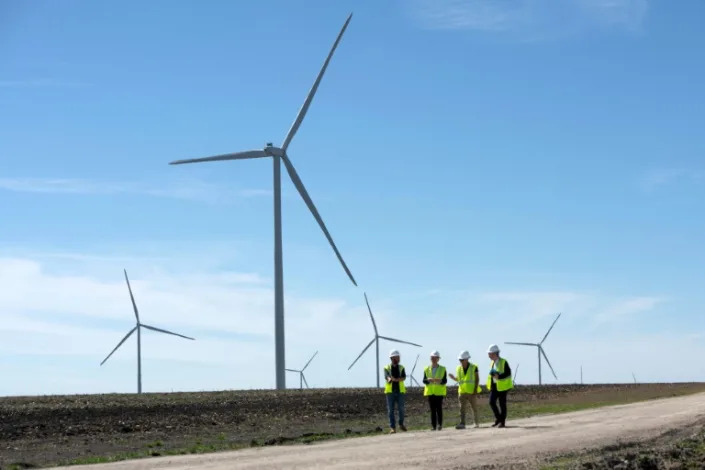Facebook and Google are handing over user data to help police prosecute abortion seekers
Katherine Tangalakis-Lippert
Sat, March 4, 2023

Marianne Ayala/Insider
Police make requests for social media user data to aid prosecution after a crime has been committed.
Sometimes, the crime is abortion and social apps are turning over user chat logs and search history.
One legal expert said social platforms may cooperate with police even if not legally required to.
As abortion bans across the nation are implemented and enforced, law enforcement is turning to social media platforms to build cases to prosecute women seeking abortions or abortion-inducing medication – and online platforms like Google and Facebook are helping.
This spring, a woman named Jessica Burgess and her daughter will stand trial in Nebraska for performing an illegal abortion — with a key piece of evidence provided by Meta, the parent company of Facebook. Burgess allegedly helped her daughter find and take pills that would induce an abortion. The teenage Burgess also faces charges for allegedly illegally disposing of the fetus' remains.
TechCrunch reported internal chat logs were provided to law enforcement officers by the social media company, which indicated the pair had discussed their plan to find the medication through the app.
Meta said in a statement regarding the Nebraska incident that it responded to "valid legal warrants from local law enforcement" prior to the Supreme Court's decision in Dobbs v. Jackson Women's Health Organization, which overturned nationwide abortion rights and allowed for bans in some states.
And though the warrants Meta responded to in this case "did not mention abortion" — since law enforcement had requested the chat logs while investigating the teen's disposal of the remains, which incidentally revealed the discussion of abortion pills — the subsequent charges reveal how data released by social media companies can be used to prosecute people for abortion, even when they are being investigated for other reasons.
Pharmacies sharing data
An investigation by ProPublica found online pharmacies that sell abortion medication such as mifepristone and misoprostol are sharing sensitive data, including users' web addresses, relative location, and search data, with Google and other third-party sites — which allows the data to be recoverable through law enforcement requests.
ProPublica found similar web trackers that capture user data on the sites of at least nine online pharmacies that offer abortion pills by mail, including Abortion Ease, BestAbortionPill.com, PrivacyPillRX, PillsOnlineRX, Secure Abortion Pills, AbortionRx, Generic Abortion Pills, Abortion Privacy, and Online Abortion Pill Rx.
None of the pharmacies immediately responded to Insider's requests for comment.
Representatives for the FBI told Insider they were "unable to accommodate" Insider's detailed request for information about the criteria required for officers to issue a request for a civilian's social media or internet history, what information is generally turned over to them in the pursuit of such information, and what channels officers used to make those requests.
Representatives for Google and the Los Angeles and New York Police Departments, two of the largest police forces in the country, did not respond to Insider's requests for comment.
"We comply with government requests for user information only where we have a good-faith belief that the law requires us to do so," a spokesperson for Meta told Insider. "In addition, we assess whether a request is consistent with internationally recognized standards on human rights, including due process, privacy, free expression and the rule of law. When we do comply, we only produce information that is narrowly tailored to that request. If we determine that a request appears to be deficient or overly broad, we push back and will fight in court, if necessary. We do not provide governments with 'back doors' to people's information."
According to internal statistics provided by Meta, the company complies with government requests for user data more than 70% of the time and receives more than 400,000 requests per year.
"Certainly, we expect that social media companies are gonna cooperate with law enforcement when they make legitimate information requests, we need them to do that," Eric Goldman, law professor at Santa Clara University School of Law and co-director of the school's High Tech Law Institute, told Insider. "But we also know that social media isn't likely to stand up to illegitimate law enforcement requests, because of the fact that they fear their own liability, or because of the fact that it's just too costly to stand up."
Goldman indicated examples where internet services affirmatively go to court to protect user interest, "but those are the exceptions."
"There's thousands of requests for every one of those cases, and there's thousands of other decisions that the company made to just turn over the data because it's just easier quicker that way," Goldman said. "So law enforcement knows that they can make requests of social media, including court requests that do not comply with law, and expect to get most of them honored simply because that is the path of least resistance for the social media services."
No incentive to protect privacy
While cases against people seeking abortions are increasingly being informed by user data provided by social media companies, those aren't the only prosecutions being built off of what people share online.
Public social media posts can be used to build cases against people for major cases including child abuse and murder, as well as against less serious incidents that could have first amendment implications, such as jokesters who tweeted threats against airlines and memes interpreted by the DOJ as election interference.
Private content by users — such as location data or messages — requires law enforcement to obtain a warrant before it can be turned over.
But "social media companies don't really have incentives to protect privacy," Sharon Docter, PhD, JD, and professor of legal issues and new media at California Lutheran University, told Insider. She said because the platforms themselves are unlikely to prioritize user privacy, the burden to do so falls on the individual user.
"Users of social media need to be concerned about privacy, and that users really need to think through the fact that their digital footprint might potentially be available to law enforcement if there's a valid search warrant," Docter added. "And they should do all they can really to protect their privacy, by looking into sending encrypted messages, by making sure their location data is off, by engaging in any efforts that they can to understand the privacy policies of the platforms that they use."
Expecting social media companies to change their policies or standardize encryption is unlikely, Docter and Goldman told Insider, since they aren't incentivized by law or user pressure to do so. However, overly broad requests made by the government are the key point of the problem, Goldman noted — not that social media is cooperating with law enforcement in the first place.
"All the angst directed social media services for being a pawn in law enforcement's game seems misdirected to me. Social media is in fact a pawn in that game," Goldman told Insider, adding people often don't want to get mad at law enforcement or the government for overreaching and instead get angry at Facebook or Google for complying with sometimes illegal requests.
"We say 'law enforcement is just trying to do their job,' right, and 'if they get some wrong along the way, but they get the bad guys, you know, the ends justify the means,'" Goldman added. "It's so tempting to give benefit of the doubt to law enforcement, and that's why it's so hard for us to confront the reality: maybe there are times they don't deserve that benefit."












